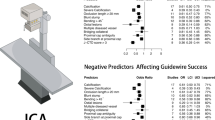Abstract
To study the relationship between percutaneous coronary intervention (PCI) success and various morphological index evaluated by coronary computed tomography angiography (CCTA) in patients with coronary chronic total occlusion (CTO). 272 Consecutive patients with 281 CTO lesions diagnosed by CCTA and invasive coronary angiography were prospectively enrolled. The luminal attenuation of proximal segment of CTO lesions was measured. Other parameters, like lesion length, coronary calcium score, torturous course, stump morphology were also recorded. The attenuation of the proximal segment of CTO lesions was significantly higher in PCI failure group than it was in PCI success group (88 ± 19.7 vs. 70.2 ± 13, p < 0.001). Lesion length in PCI failure group was longer than those in PCI success group (20.4 ± 11.2 vs. 15.1 ± 5.85 mm, p < 0.001) and lesions in PCI failure group were more heavily calcified than lesions in PCI success group (Agatston score 61 vs. 5.7, p < 0.001). The attenuation of the proximal segment of CTO lesions, along with occlusion length and total coronary calcium score were significant independent predictors of PCI failure. The attenuation of the proximal segment of CTO lesions, along with occlusion length and total coronary calcium score as assessed by CCTA have predictive value for PCI outcomes.


Similar content being viewed by others
References
Stone GW, Kandzari DE, Mehran R et al (2005) Percutaneous recanalization of chronically occluded coronary arteries: a consensus document: part I. Circulation 112:2364–2372
Suero JA, Marso SP, Jones PG et al (2001) Procedural outcomes and long-term survival among patients undergoing percutaneous coronary intervention of a chronic total occlusion in native coronary arteries: 20-year experience. J Am Coll Cardiol 38:409–414
Prasad A, Rihal CS, Lennon RJ et al (2007) Trends in outcomes after percutaneous coronary intervention for chronic total occlusions: 25-year experience from the Mayo Clinic. J Am Coll Cardiol 49:1611–1618
Chung CM, Nakamura S, Tanaka K et al (2003) Effect of recanalization of chronic total occlusions on global and regional left ventricular function in patients with or without previous myocardial infarction. Catheter Cardiovasc Interv 60:368–374
Olivari Z, Rubartelli P, Piscione F et al (2003) Immediate results and one-year clinical outcome after percutaneous coronary interventions in chronic total occlusions: data from a multicenter, prospective, observational study (TOAST-GISE). J Am Coll Cardiol 41:1672–1678
Hannan EL, Racz M, Holmes DR et al (2006) Impact of completeness of percutaneous coronary intervention revascularization on long-term outcomes in the stent era. Circulation 113:2406–2412
Li M, Zhang J, Pan J et al (2013) Coronary total occlusion lesions: linear intrathrombus enhancement at CT predicts better outcome of percutaneous coronary intervention. Radiology 266:443–451
Li M, Zhang J, Pan J et al (2013) Obstructive coronary artery disease: reverse attenuation gradient sign at CT indicates distal retrograde flow—a useful sign for differentiating chronic total occlusion from subtotal occlusion. Radiology 266:766–772
Dalager MG, Bøttcher M, Andersen G et al (2011) Impact of luminal density on plaque classification by CT coronary angiography. Int J Cardiovasc Imaging 27:593–600
Mehran R, Claessen BE, Godino C et al (2011) Long-term outcome of percutaneous coronary intervention for chronic total occlusions. JACC Cardiovasc Interv 4:952–961
Jones DA, Weerackody R, Rathod K et al (2012) Successful recanalization of chronic total occlusions is associated with improved long-term survival. JACC Cardiovasc Interv 5:380–388
Grantham JA, Marso SP, Spertus J et al (2009) Chronic total occlusion angioplasty in the United States. J Am Coll Cardiol Int 2:479–486
Rastan AJ, Boudriot E, Falk V et al (2008) Frequency and pattern of de-novo three-vessel and left main coronary artery disease; insights from single center enrollment in the SYNTAX study. Eur J Cardiothorac Surg 34:376–382
Morino Y, Abe M, Morimoto T et al (2011) Predicting successful guidewire crossing through chronic total occlusion of native coronary lesions within 30 minutes: the J-CTO (Multicenter CTO Registry in Japan) score as a difficulty grading and time assessment tool. JACC Cardiovasc Interv 4:213–221
García-García HM, van Mieghem CA, Gonzalo N et al (2009) Computed tomography in total coronary occlusions (CTTO registry): radiation exposure and predictors of successful percutaneous intervention. EuroIntervention 4:607–616
Hoe J (2009) CT coronary angiography of chronic total occlusions of the coronary arteries: how to recognize and evaluate and usefulness for planning percutaneous coronary interventions. Int J Cardiovasc Imaging 25(Suppl 1):43–54
Soon KH, Cox N, Wong A et al (2007) CT coronary angiography predicts the outcome of percutaneous coronary intervention of chronic total occlusion. J Interv Cardiol 20:359–366
Choi JH, Song YB, Hahn JY et al (2011) Three-dimensional quantitative volumetry of chronic total occlusion plaque using coronary multidetector computed tomography. Circ J 75:366–375
Cho JR, Kim YJ, Ahn CM et al (2010) Quantification of regional calcium burden in chronic total occlusion by 64-slice multi-detector computed tomography and procedural outcomes of percutaneous coronary intervention. Int J Cardiol 145:9–14
Stone GW, Reifart NJ, Moussa I et al (2005) Percutaneous recanalization of chronically occluded coronary arteries: a consensus document: part II. Circ Cardiovasc Imaging 112:2530–2537
Fefer P, Robert N, Qiang B et al (2012) Characterisation of a novel porcine coronary artery CTO model. EuroIntervention 7:1444–1452
Acknowledgments
This study was Granted by the Ministry of Science and Technology of China (2007BAI05B02).
Conflict of interest
There are no conflicts of interest.
Author information
Authors and Affiliations
Corresponding author
Rights and permissions
About this article
Cite this article
Chen, Y., Lu, B., Hou, Zh. et al. Predicting successful percutaneous coronary intervention in patients with chronic total occlusion: the incremental value of a novel morphological parameter assessed by computed tomography. Int J Cardiovasc Imaging 31, 1263–1269 (2015). https://doi.org/10.1007/s10554-015-0679-x
Received:
Accepted:
Published:
Issue Date:
DOI: https://doi.org/10.1007/s10554-015-0679-x




